Attached files
| file | filename |
|---|---|
| EX-99.1 - EXHIBIT 99.1 - Arconic Corp | a52383128ex991.htm |
| 8-K - ARCONIC CORPORATION 8-K - Arconic Corp | a52383128.htm |
Exhibit 99.2
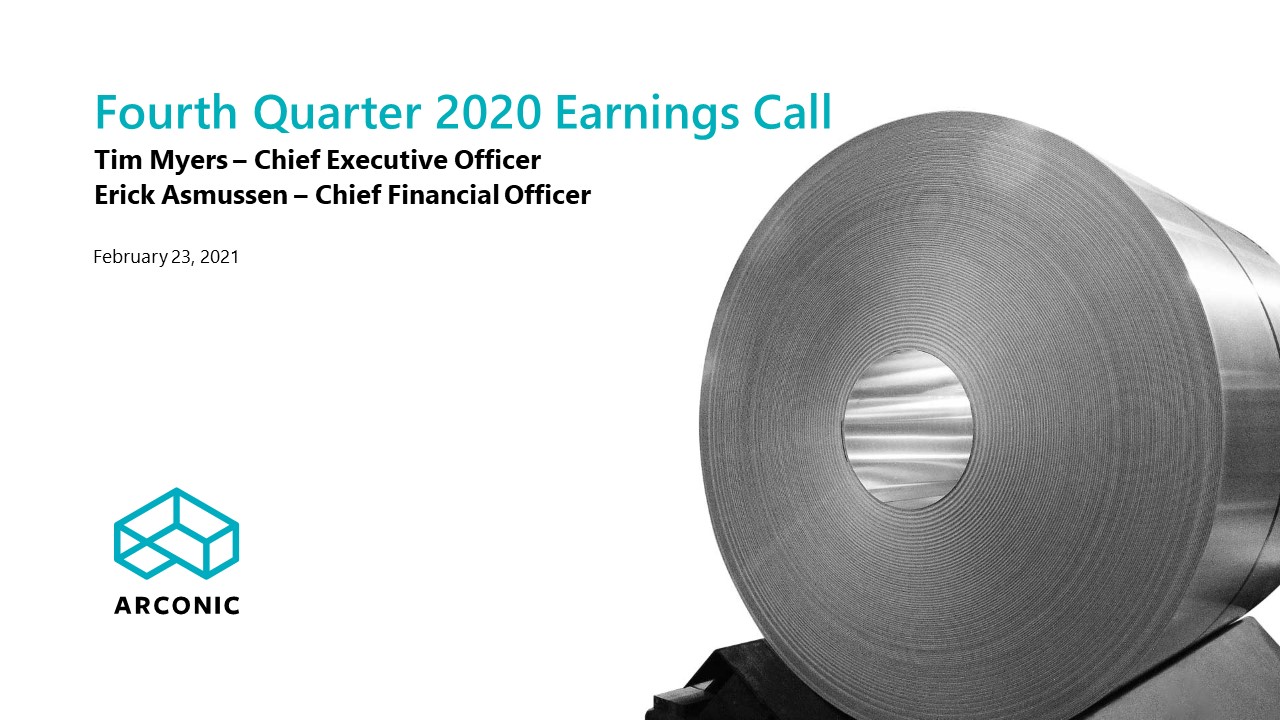
Fourth Quarter 2020 Earnings Call Tim Myers – Chief Executive OfficerErick Asmussen – Chief
Financial Officer February 23, 2021

Important Information 2 Forward-Looking Statements This presentation contains statements that
relate to future events and expectations and, as such, constitute forward-looking statements within the meaning of the Private Securities Litigation Reform Act of 1995. Forward-looking statements include those containing such words as
"anticipates," "believes," "could," "estimates," "expects," "forecasts," "goal," "guidance," "intends," "may," "outlook," "plans," "projects," "seeks," "sees," "should," "targets," "will," "would," or other words of similar meaning. All
statements that reflect Arconic’s expectations, assumptions, projections, beliefs or opinions about the future, other than statements of historical fact, are forward-looking statements, including, without limitation, statements regarding
forecasts and expectations relating to the aerospace, ground transportation, building and construction, industrial, packaging and other end markets; statements and guidance regarding future financial results, operating performance, working
capital, cash flows, liquidity and financial position; statements about cost savings and restructuring programs; statements about Arconic's strategies, outlook, business and financial prospects; statements related to costs associated with
pension and other post-retirement benefit plans; statements regarding projected sources of cash flow; statements regarding potential legal liability; statements regarding the potential impact of the COVID-19 pandemic; and statements regarding
actions to mitigate the impact of COVID-19. These statements reflect beliefs and assumptions that are based on Arconic’s perception of historical trends, current conditions and expected future developments, as well as other factors Arconic
believes are appropriate in the circumstances. Forward-looking statements are not guarantees of future performance. Although Arconic believes that the expectations reflected in any forward-looking statements are based on reasonable
assumptions, these expectations may not be attained and it is possible that actual results may differ materially from those indicated by these forward-looking statements due to a variety of risks, uncertainties and changes in circumstances,
many of which are beyond Arconic’s control. Such risks and uncertainties include, but are not limited to: (a) existing and future adverse effects in connection with COVID-19 and the potential for COVID-19 related issues to significantly
heighten the other risks customarily associated with our business (including those identified below); (b) the risk that we are unable to fully realize the expected benefits of the separation, or that dissynergy costs, costs of restructuring
transactions and other costs incurred in connection with the separation, once fully realized, will exceed our estimates; (c) the risk of operating our business as a standalone company, which could result in additional demands on Arconic’s
resources, systems, procedures and controls, disruption of its ongoing business, and diversion of management’s attention from other business concerns; (d) deterioration in global economic and financial market conditions generally; (e)
unfavorable changes in the markets served by Arconic; (f) the inability to achieve the level of revenue growth, cash generation, cost savings, benefits of our management of legacy liabilities, improvement in profitability and margins, fiscal
discipline, or strengthening of competitiveness and operations anticipated or targeted; (g) competition from new product offerings, disruptive technologies, industry consolidation or other developments; (h) political, economic, and regulatory
risks relating to Arconic’s global operations, including compliance with U.S. and foreign trade and tax laws, sanctions, embargoes and other regulations; (i) manufacturing difficulties or other issues that impact product performance, quality
or safety; (j) the inability to meet demand for our products successfully or to mitigate the impact of cancellations of orders or reductions or delays caused by supply chain disruption; (k) a material disruption of Arconic’s operations,
particularly at one or more of Arconic’s manufacturing facilities; (l) the inability to develop innovative new products or implement technology initiatives successfully; (m) challenges to or infringements on Arconic’s intellectual property
rights; (n) Arconic’s inability to realize expected benefits, in each case as planned and by targeted completion dates, from acquisitions, divestitures, facility closures, curtailments, expansions, or joint ventures; (o) the impact of
potential cyber attacks and information technology or data security breaches; (p) the loss of significant customers or adverse changes in customers’ business or financial condition; (q) a significant downturn in the business or financial
condition of a key supplier; (r) adverse changes in discount rates or investment returns on pension assets; (s) our inability to adequately mitigate the impact of changes in aluminum prices and foreign currency exchange rates on costs and
results; (t) the outcome of contingencies, including legal proceedings, government or regulatory investigations, and environmental remediation, which can expose Arconic to substantial costs and liabilities; (u) a determination by the IRS that
the distribution or certain related transactions should be treated as taxable transactions; (v) risks associated with indebtedness, including potential restriction on our operations and the impact of events of default; and (w) the other risk
factors summarized in Arconic’s Form 10-K for the year ended December 31, 2020 and other reports filed with the U.S. Securities and Exchange Commission (SEC). The above list of factors is not exhaustive or necessarily in order of importance.
Market projections are subject to the risks discussed above and other risks in the market. The statements in this presentation are made as of the date of this presentation, even if subsequently made available by Arconic on its website or
otherwise. Arconic disclaims any intention or obligation to update publicly any forward-looking statements, whether in response to new information, future events, or otherwise, except as required by applicable law.

Important Information (cont’d) 3 Non-GAAP Financial MeasuresSome of the information included in
this presentation is derived from Arconic’s consolidated financial information but is not presented in Arconic’s financial statements prepared in accordance with accounting principles generally accepted in the United States of America (GAAP).
Certain of these financial measures are considered “non-GAAP financial measures” under SEC rules. These non-GAAP financial measures supplement our GAAP disclosures and should not be considered an alternative to any measure of performance or
financial condition as determined in accordance with GAAP, and investors should consider Arconic’s performance and financial condition as reported under GAAP and all other relevant information when assessing the performance or financial
condition of Arconic. Non-GAAP financial measures have limitations as analytical tools, and investors should not consider them in isolation or as a substitute for analysis of the results or financial condition as reported under GAAP. Non-GAAP
financial measures presented by Arconic may not be comparable to non-GAAP financial measures presented by other companies. Reconciliations to the most directly comparable GAAP financial measures and management’s rationale for the use of the
non-GAAP financial measures can be found in the schedules to this presentation. Arconic has not provided reconciliations of any forward-looking non-GAAP financial measures, such as adjusted EBITDA, and free cash flow to the most directly
comparable GAAP financial measures because such reconciliations are not available without unreasonable efforts due to the variability and complexity with respect to the charges and other components excluded from the non-GAAP measures, such as
the effects of metal price lag, foreign currency movements, gains or losses on sales of assets, taxes, and any future restructuring or impairment charges. These reconciling items are in addition to the inherent variability already included in
the GAAP measures, which includes, but is not limited to, price/mix and volume. Arconic believes such reconciliations would imply a degree of precision that would be confusing or misleading to investors.Other InformationEffective July 1,
2020, the Company changed its inventory cost method to average cost for all U.S. inventories previously carried at last-in, first-out (LIFO) cost. The effects of the change in accounting principle from LIFO to average cost have been
retrospectively applied to all prior periods presented. See the Company’s Form 10-K for the year ended December 31, 2020 and Form 10-Q for the three and nine months ended September 30, 2020 for further information.
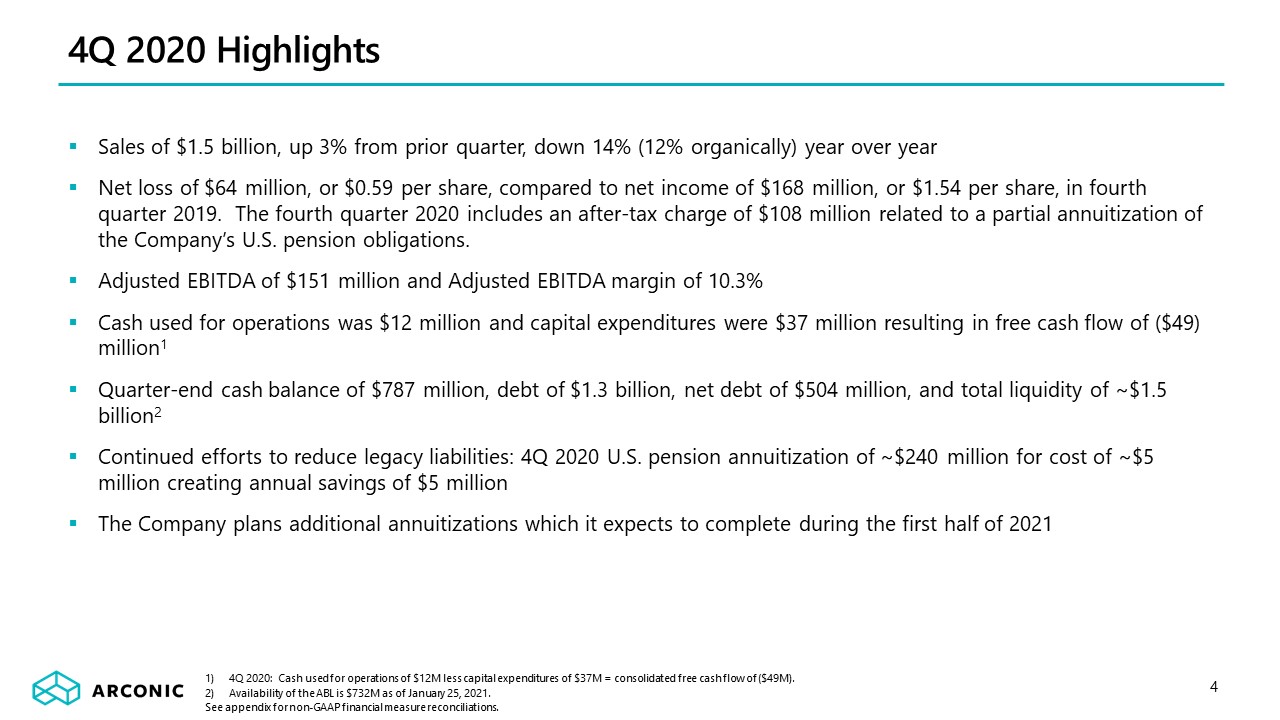
4Q 2020 Highlights 4 4Q 2020: Cash used for operations of $12M less capital expenditures of $37M =
consolidated free cash flow of ($49M).Availability of the ABL is $732M as of January 25, 2021.See appendix for non-GAAP financial measure reconciliations. Sales of $1.5 billion, up 3% from prior quarter, down 14% (12% organically) year over
yearNet loss of $64 million, or $0.59 per share, compared to net income of $168 million, or $1.54 per share, in fourth quarter 2019. The fourth quarter 2020 includes an after-tax charge of $108 million related to a partial annuitization of
the Company’s U.S. pension obligations.Adjusted EBITDA of $151 million and Adjusted EBITDA margin of 10.3%Cash used for operations was $12 million and capital expenditures were $37 million resulting in free cash flow of ($49)
million1Quarter-end cash balance of $787 million, debt of $1.3 billion, net debt of $504 million, and total liquidity of ~$1.5 billion2Continued efforts to reduce legacy liabilities: 4Q 2020 U.S. pension annuitization of ~$240 million for
cost of ~$5 million creating annual savings of $5 millionThe Company plans additional annuitizations which it expects to complete during the first half of 2021
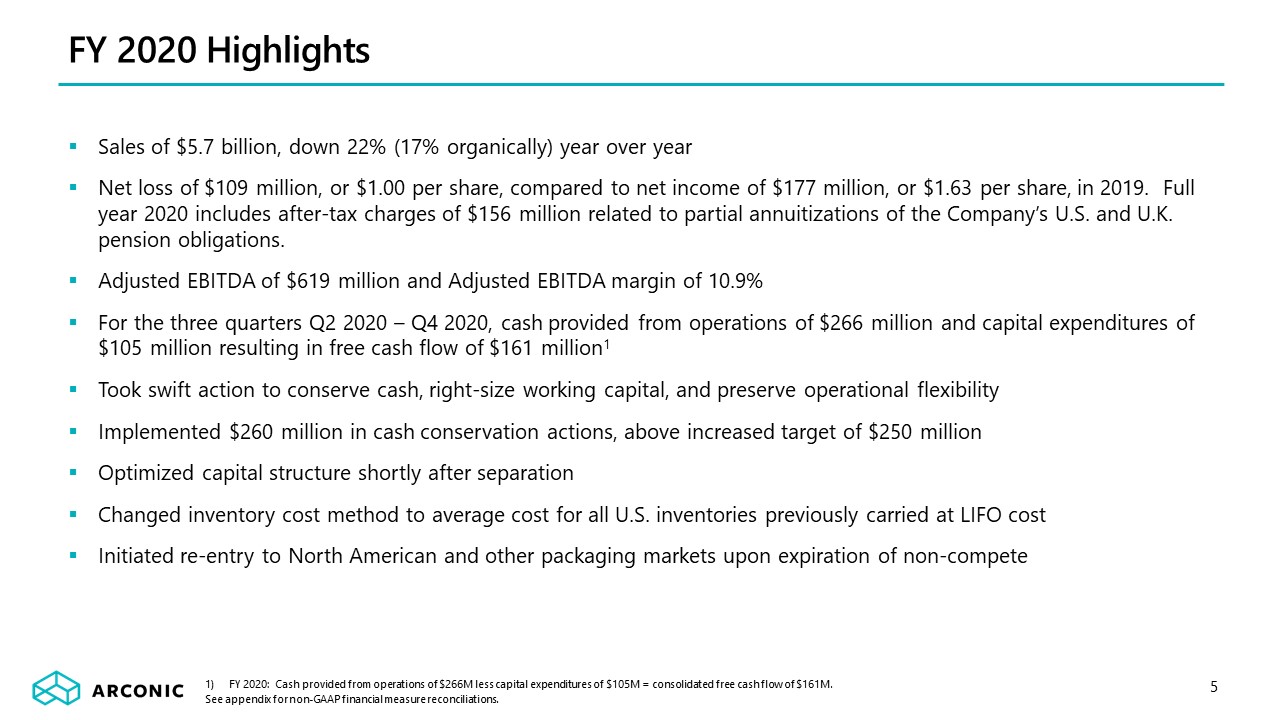
FY 2020 Highlights 5 FY 2020: Cash provided from operations of $266M less capital expenditures of
$105M = consolidated free cash flow of $161M.See appendix for non-GAAP financial measure reconciliations. Sales of $5.7 billion, down 22% (17% organically) year over yearNet loss of $109 million, or $1.00 per share, compared to net income of
$177 million, or $1.63 per share, in 2019. Full year 2020 includes after-tax charges of $156 million related to partial annuitizations of the Company’s U.S. and U.K. pension obligations.Adjusted EBITDA of $619 million and Adjusted EBITDA
margin of 10.9%For the three quarters Q2 2020 – Q4 2020, cash provided from operations of $266 million and capital expenditures of $105 million resulting in free cash flow of $161 million1Took swift action to conserve cash, right-size working
capital, and preserve operational flexibilityImplemented $260 million in cash conservation actions, above increased target of $250 millionOptimized capital structure shortly after separationChanged inventory cost method to average cost for
all U.S. inventories previously carried at LIFO costInitiated re-entry to North American and other packaging markets upon expiration of non-compete
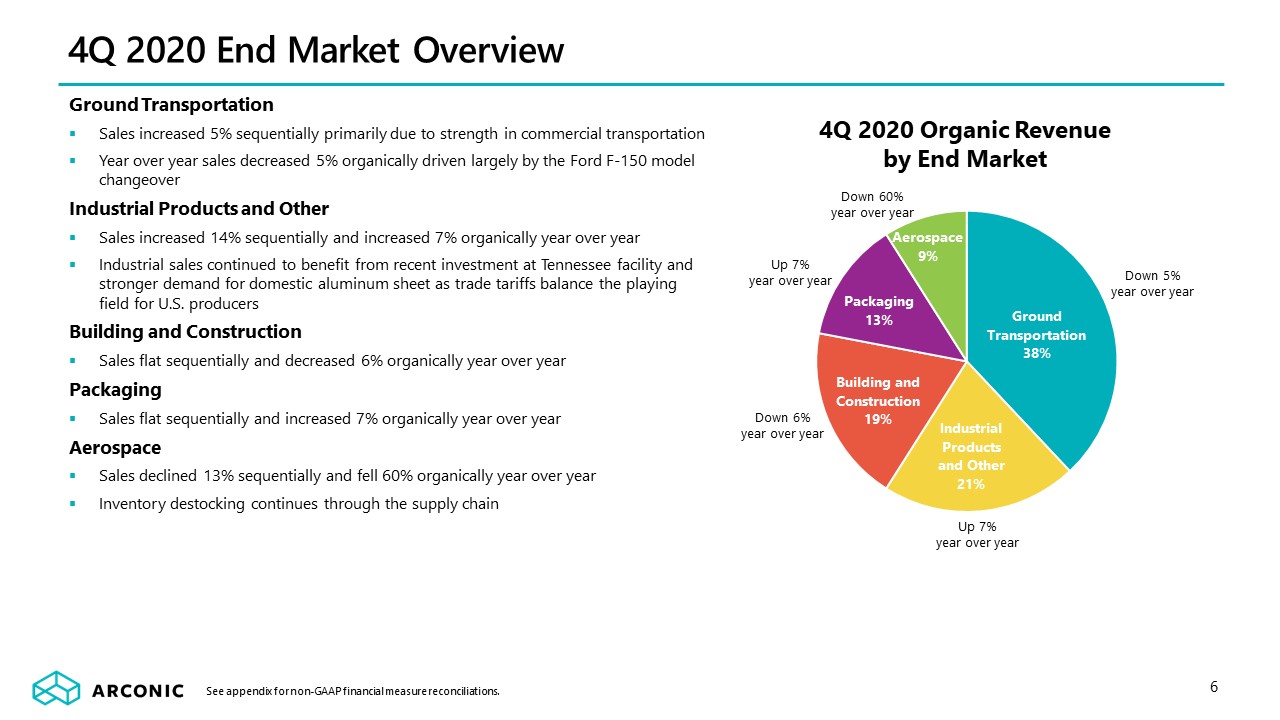
4Q 2020 End Market Overview 6 Down 5%year over year Ground TransportationSales increased 5%
sequentially primarily due to strength in commercial transportation Year over year sales decreased 5% organically driven largely by the Ford F-150 model changeoverIndustrial Products and OtherSales increased 14% sequentially and increased 7%
organically year over yearIndustrial sales continued to benefit from recent investment at Tennessee facility and stronger demand for domestic aluminum sheet as trade tariffs balance the playing field for U.S. producersBuilding and
ConstructionSales flat sequentially and decreased 6% organically year over yearPackagingSales flat sequentially and increased 7% organically year over yearAerospaceSales declined 13% sequentially and fell 60% organically year over
yearInventory destocking continues through the supply chain Up 7%year over year See appendix for non-GAAP financial measure reconciliations. Down 60%year over year Down 6%year over year Up 7%year over year 4Q 2020 Organic Revenueby End
Market

4Q 2020 Revenue and EBITDA Decline Drivers Revenue Other includes aluminum price ($4M) and FX
$5M.Adjusted EBITDA Other includes certain employee retirement benefit costs (non-service costs) $21M, contractual settlement charges in 4Q19 $7, portfolio actions $3, and FX $2M. See appendix for non-GAAP financial measure
reconciliations. 7 Revenue Adjusted EBITDA $M Year over Year % $M Year over Year % 4Q 2019 Previously Reported $1,708 $176 Change in Inventory Accounting Impact - (23) Metal Lag - 6 4Q 2019
Recast $1,708 $159 Price (12) (1%) (12) (8%) Volume/Mix (195) (11%) (84) (53%) Net Savings - - 55 35% Divestitures (40) (2%) 0 0% Other1 1 0% 33 21% 4Q 2020 $1,462 (14%) $151 (5%)
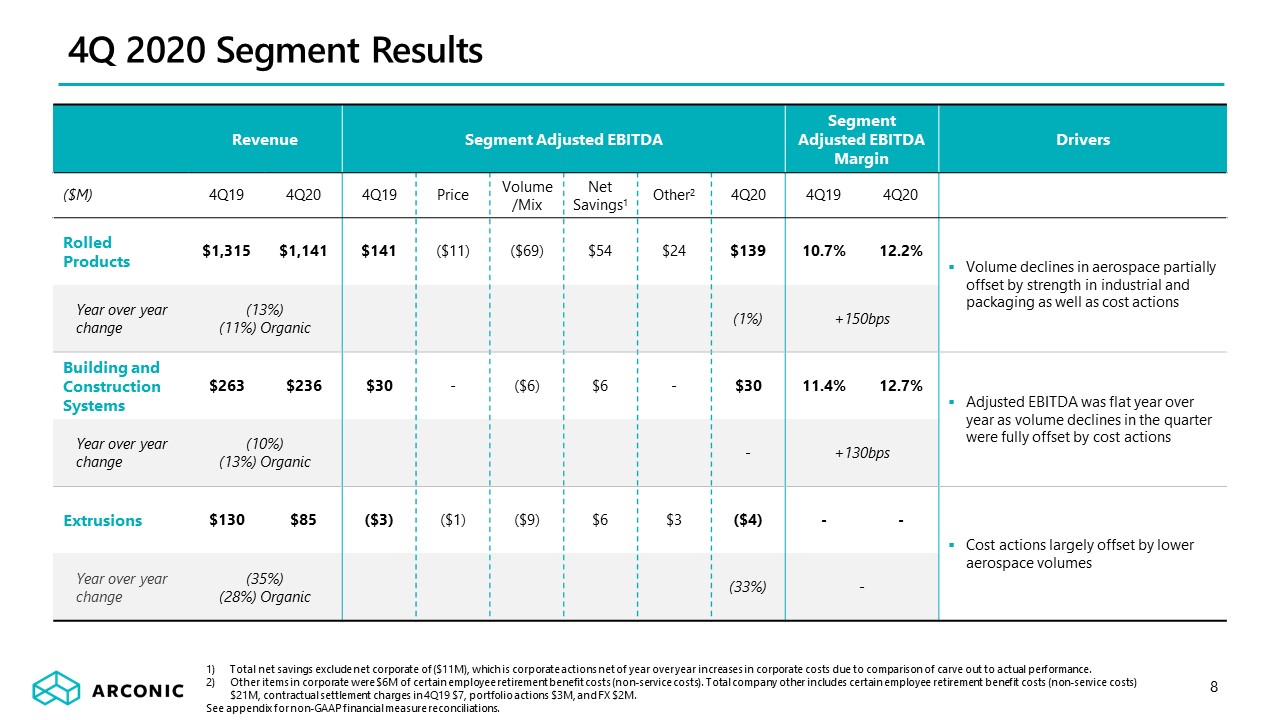
4Q 2020 Segment Results 8 Total net savings exclude net corporate of ($11M), which is corporate
actions net of year over year increases in corporate costs due to comparison of carve out to actual performance.Other items in corporate were $6M of certain employee retirement benefit costs (non-service costs). Total company other includes
certain employee retirement benefit costs (non-service costs) $21M, contractual settlement charges in 4Q19 $7, portfolio actions $3M, and FX $2M.See appendix for non-GAAP financial measure reconciliations. Revenue Segment Adjusted
EBITDA Segment Adjusted EBITDA Margin Drivers ($M) 4Q19 4Q20 4Q19 Price Volume/Mix Net Savings1 Other2 4Q20 4Q19 4Q20 Rolled Products $1,315 $1,141 $141 ($11) ($69) $54 $24 $139 10.7% 12.2% Volume
declines in aerospace partially offset by strength in industrial and packaging as well as cost actions Year over year change (13%)(11%) Organic (1%) +150bps Building and Construction
Systems $263 $236 $30 - ($6) $6 - $30 11.4% 12.7% Adjusted EBITDA was flat year over year as volume declines in the quarter were fully offset by cost actions Year over year change (10%)(13%)
Organic - +130bps Extrusions $130 $85 ($3) ($1) ($9) $6 $3 ($4) - - Cost actions largely offset by lower aerospace volumes Year over year change (35%)(28%) Organic (33%) -
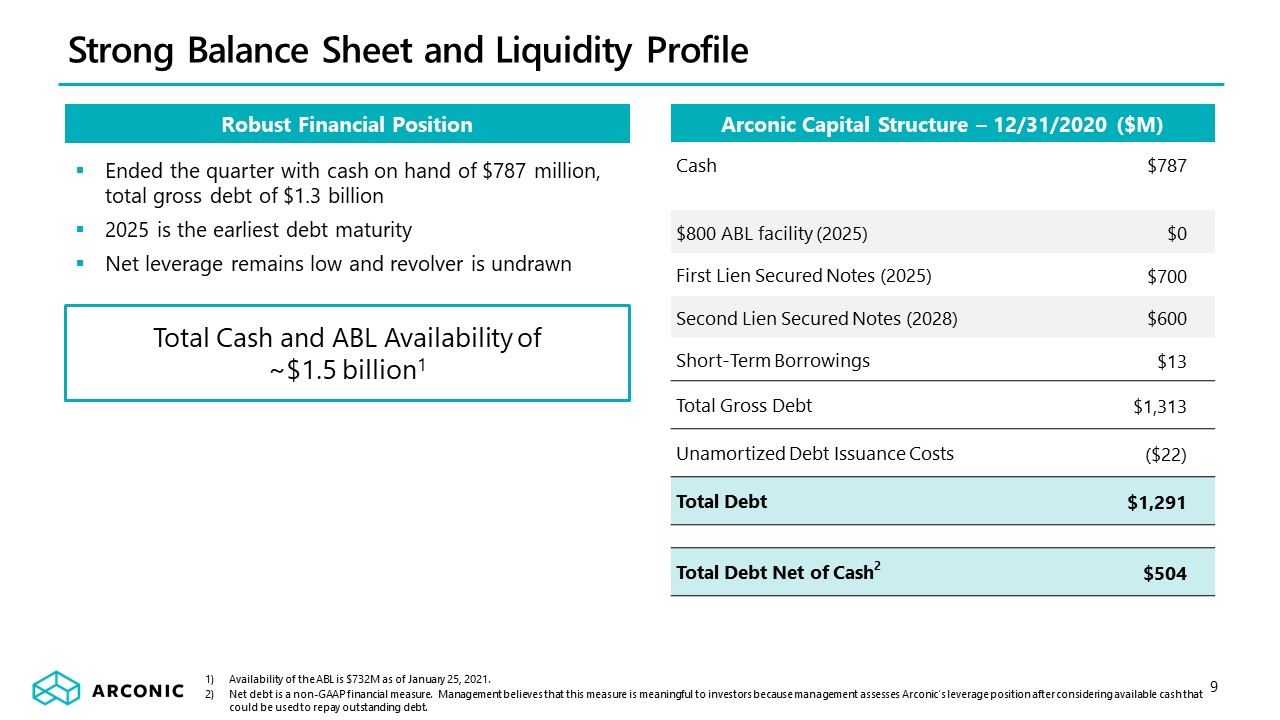
Strong Balance Sheet and Liquidity Profile 9 Arconic Capital Structure – 12/31/2020
($M) Cash $787 $800 ABL facility (2025) $0 First Lien Secured Notes (2025) $700 Second Lien Secured Notes (2028) $600 Short-Term Borrowings $13 Total Gross Debt $1,313 Unamortized Debt Issuance Costs ($22) Total
Debt $1,291 Total Debt Net of Cash2 $504 Robust Financial Position Total Cash and ABL Availability of~$1.5 billion1 Ended the quarter with cash on hand of $787 million, total gross debt of $1.3 billion2025 is the earliest debt
maturityNet leverage remains low and revolver is undrawn Availability of the ABL is $732M as of January 25, 2021.Net debt is a non-GAAP financial measure. Management believes that this measure is meaningful to investors because management
assesses Arconic’s leverage position after considering available cash that could be used to repay outstanding debt.

Ground TransportationRevenue expected to grow ~25-35% year over year due to strong automotive
consumer demand, new content wins, and commercial transportation recoveryCommercial transportation expected to improve significantly driven by overall recovery in heavy duty truck builds Industrial Products and OtherRevenue expected to
increase ~15-20% year over year with the ramp up of the Tennessee investment and impact of the U.S. trade action on 18 countries Building and ConstructionRevenue expected to be roughly flat year over year despite weak market due to new
products and share gainsNorth American construction markets expected to remain weak and modest year over year growth expected in Europe PackagingRevenue expected to be flat or show modest growth as North American production impact
anticipated in 2022 AerospaceRevenue expected to be down ~25-30% year over year as industry works through supply chain surplus1H21 expected to remain depressed, with recovery expected later in the year; 2H21 expected to show growth over
2H20 FY 2021 Organic Revenue Outlook by End Market 10 FY 2021 Organic RevenueYear over Year Trajectory

End Market Tailwinds More than Support Latent Capacity Utilization 11 Packaging:demand growth and
domestic supply gap Current domestic production deficit:1.2B pounds3 Industrial:growth in U.S. as imports decline due to international trade case Expected industrial import gap:1.1B pounds2 Only need to capture ~20% of expected ~3B
pounds of domestic demand to fill 600M pounds latent capacityExpected to result in EBITDA uplift of ~$100M-$120M compared to 2019 levels Ground Transportation:automotive light-weighting and production volume growth Expected North American
autobody sheet demand growth over next five years:0.9B pounds1 Demand Volumes END MARKET OPPORTUNITY CRU Group, updated July 16, 2020.Assumes import reduction in line with 2018 international trade case. Harbor Aluminum, US Aluminum Rolled
Products Intelligence Report, June 2020.

Looking Forward 12 Keep employees safeMaintain 2020 momentum on cost actions and productivity
measures to drive margin performanceCapture growth from platform expansion and market recovery of ground transportationContinue to capitalize on favorable industrial market conditionsPosition for aerospace rebound from current troughSecure
new packaging opportunities for 2022 and beyondCompany focused on deleveraging legacy liabilities and expects to complete additional annuitizations during the first half of 2021 Full-year 2021 revenue assumes LME $2,030/mt + MWP $320/mt
($2,350 total).Arconic has not provided reconciliations of any forward-looking non-GAAP financial measures, such as adjusted EBITDA, and free cash flow to the most directly comparable GAAP financial measures because such reconciliations are
not available without unreasonable efforts due to the variability and complexity with respect to the charges and other components excluded from the non-GAAP measures, such as the effects of metal price lag, foreign currency movements, equity
income, gains or losses on sales of assets, taxes, and any future restructuring or impairment charges. These reconciling items are in addition to the inherent variability already included in the GAAP measures, which includes, but is not
limited to, price/mix and volume. Arconic believes such reconciliations would imply a degree of precision that would be confusing or misleading to investors.Excludes the impacts of future annuitizations and includes approximately $350 million
funding of legacy pension, OPEB, and environmental liabilities. FY 2021 OutlookRevenue1: $6.6B – $6.9BAdjusted EBITDA2: $675M – $725MFree cash flow2,3: ($50M) – $50M
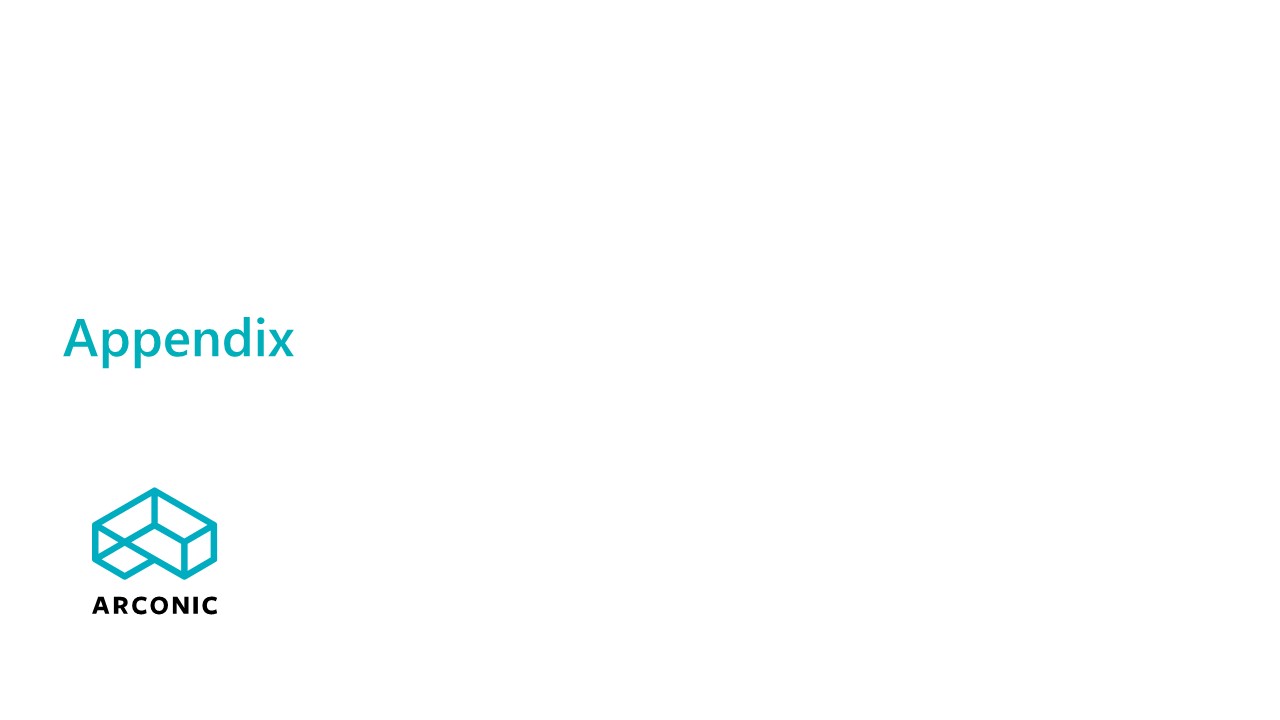
Appendix
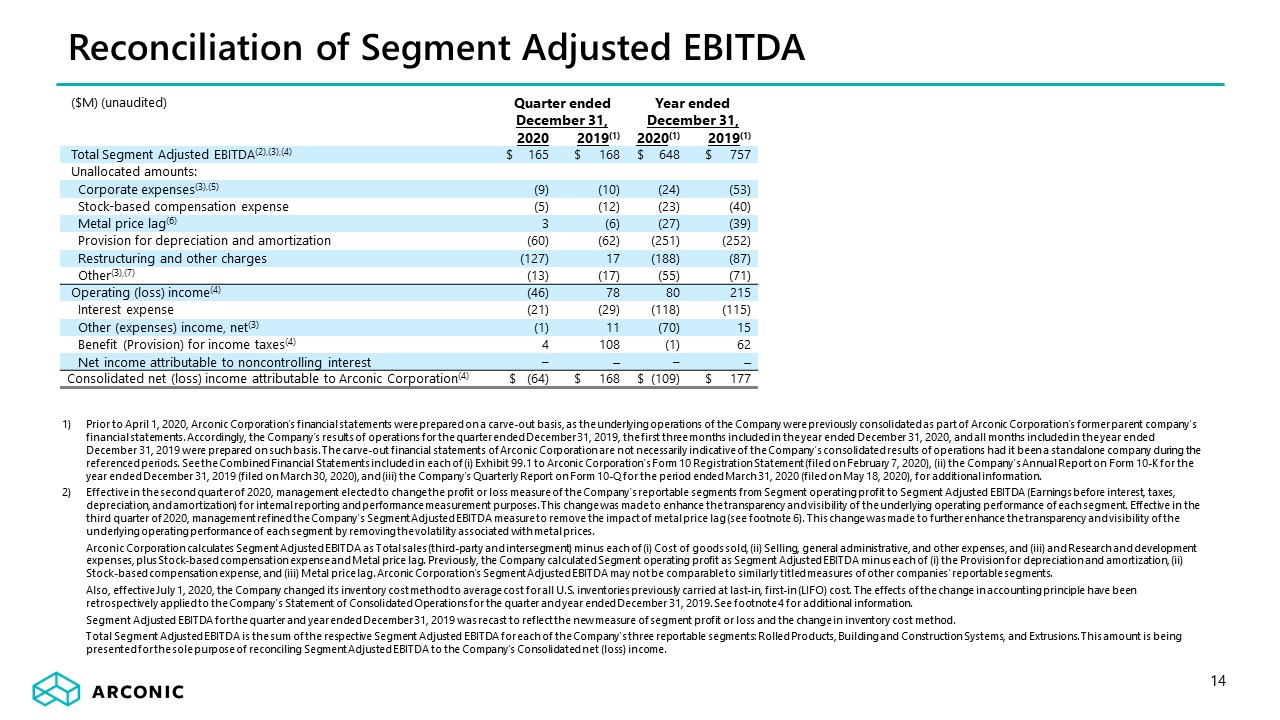
14 ($M) (unaudited) Quarter ended Year ended December 31, December
31, 2020 2019(1) 2020(1) 2019(1) Total Segment Adjusted EBITDA(2),(3),(4) $ 165 $ 168 $ 648 $ 757 Unallocated amounts: Corporate expenses(3),(5) (9) (10) (24) (53) Stock-based compensation
expense (5) (12) (23) (40) Metal price lag(6) 3 (6) (27) (39) Provision for depreciation and amortization (60) (62) (251) (252) Restructuring and other charges (127) 17 (188) (87)
Other(3),(7) (13) (17) (55) (71) Operating (loss) income(4) (46) 78 80 215 Interest expense (21) (29) (118) (115) Other (expenses) income, net(3) (1) 11 (70) 15 Benefit (Provision) for income
taxes(4) 4 108 (1) 62 Net income attributable to noncontrolling interest – – – – Consolidated net (loss) income attributable to Arconic Corporation(4) $ (64) $ 168 $ (109) $ 177 Reconciliation of Segment
Adjusted EBITDA Prior to April 1, 2020, Arconic Corporation’s financial statements were prepared on a carve-out basis, as the underlying operations of the Company were previously consolidated as part of Arconic Corporation’s former parent
company’s financial statements. Accordingly, the Company’s results of operations for the quarter ended December 31, 2019, the first three months included in the year ended December 31, 2020, and all months included in the year ended December
31, 2019 were prepared on such basis. The carve-out financial statements of Arconic Corporation are not necessarily indicative of the Company’s consolidated results of operations had it been a standalone company during the referenced periods.
See the Combined Financial Statements included in each of (i) Exhibit 99.1 to Arconic Corporation’s Form 10 Registration Statement (filed on February 7, 2020), (ii) the Company’s Annual Report on Form 10-K for the year ended December 31, 2019
(filed on March 30, 2020), and (iii) the Company’s Quarterly Report on Form 10-Q for the period ended March 31, 2020 (filed on May 18, 2020), for additional information.Effective in the second quarter of 2020, management elected to change the
profit or loss measure of the Company’s reportable segments from Segment operating profit to Segment Adjusted EBITDA (Earnings before interest, taxes, depreciation, and amortization) for internal reporting and performance measurement
purposes. This change was made to enhance the transparency and visibility of the underlying operating performance of each segment. Effective in the third quarter of 2020, management refined the Company’s Segment Adjusted EBITDA measure to
remove the impact of metal price lag (see footnote 6). This change was made to further enhance the transparency and visibility of the underlying operating performance of each segment by removing the volatility associated with metal
prices.Arconic Corporation calculates Segment Adjusted EBITDA as Total sales (third-party and intersegment) minus each of (i) Cost of goods sold, (ii) Selling, general administrative, and other expenses, and (iii) and Research and development
expenses, plus Stock-based compensation expense and Metal price lag. Previously, the Company calculated Segment operating profit as Segment Adjusted EBITDA minus each of (i) the Provision for depreciation and amortization, (ii) Stock-based
compensation expense, and (iii) Metal price lag. Arconic Corporation’s Segment Adjusted EBITDA may not be comparable to similarly titled measures of other companies’ reportable segments.Also, effective July 1, 2020, the Company changed its
inventory cost method to average cost for all U.S. inventories previously carried at last-in, first-in (LIFO) cost. The effects of the change in accounting principle have been retrospectively applied to the Company’s Statement of Consolidated
Operations for the quarter and year ended December 31, 2019. See footnote 4 for additional information.Segment Adjusted EBITDA for the quarter and year ended December 31, 2019 was recast to reflect the new measure of segment profit or loss
and the change in inventory cost method.Total Segment Adjusted EBITDA is the sum of the respective Segment Adjusted EBITDA for each of the Company's three reportable segments: Rolled Products, Building and Construction Systems, and
Extrusions. This amount is being presented for the sole purpose of reconciling Segment Adjusted EBITDA to the Company's Consolidated net (loss) income.
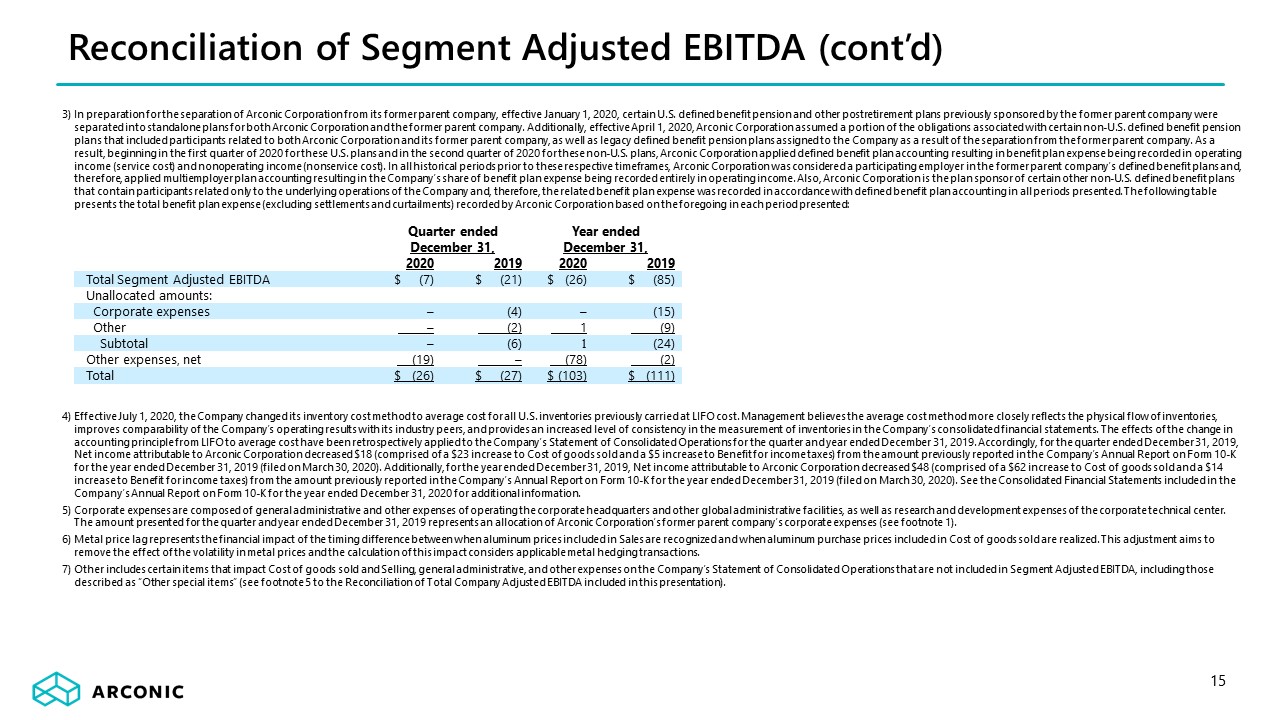
3) In preparation for the separation of Arconic Corporation from its former parent company, effective
January 1, 2020, certain U.S. defined benefit pension and other postretirement plans previously sponsored by the former parent company were separated into standalone plans for both Arconic Corporation and the former parent company.
Additionally, effective April 1, 2020, Arconic Corporation assumed a portion of the obligations associated with certain non-U.S. defined benefit pension plans that included participants related to both Arconic Corporation and its former
parent company, as well as legacy defined benefit pension plans assigned to the Company as a result of the separation from the former parent company. As a result, beginning in the first quarter of 2020 for these U.S. plans and in the second
quarter of 2020 for these non-U.S. plans, Arconic Corporation applied defined benefit plan accounting resulting in benefit plan expense being recorded in operating income (service cost) and nonoperating income (nonservice cost). In all
historical periods prior to these respective timeframes, Arconic Corporation was considered a participating employer in the former parent company’s defined benefit plans and, therefore, applied multiemployer plan accounting resulting in the
Company’s share of benefit plan expense being recorded entirely in operating income. Also, Arconic Corporation is the plan sponsor of certain other non-U.S. defined benefit plans that contain participants related only to the underlying
operations of the Company and, therefore, the related benefit plan expense was recorded in accordance with defined benefit plan accounting in all periods presented. The following table presents the total benefit plan expense (excluding
settlements and curtailments) recorded by Arconic Corporation based on the foregoing in each period presented:4) Effective July 1, 2020, the Company changed its inventory cost method to average cost for all U.S. inventories previously carried
at LIFO cost. Management believes the average cost method more closely reflects the physical flow of inventories, improves comparability of the Company’s operating results with its industry peers, and provides an increased level of
consistency in the measurement of inventories in the Company’s consolidated financial statements. The effects of the change in accounting principle from LIFO to average cost have been retrospectively applied to the Company’s Statement of
Consolidated Operations for the quarter and year ended December 31, 2019. Accordingly, for the quarter ended December 31, 2019, Net income attributable to Arconic Corporation decreased $18 (comprised of a $23 increase to Cost of goods sold
and a $5 increase to Benefit for income taxes) from the amount previously reported in the Company’s Annual Report on Form 10-K for the year ended December 31, 2019 (filed on March 30, 2020). Additionally, for the year ended December 31, 2019,
Net income attributable to Arconic Corporation decreased $48 (comprised of a $62 increase to Cost of goods sold and a $14 increase to Benefit for income taxes) from the amount previously reported in the Company’s Annual Report on Form 10-K
for the year ended December 31, 2019 (filed on March 30, 2020). See the Consolidated Financial Statements included in the Company’s Annual Report on Form 10-K for the year ended December 31, 2020 for additional information.5) Corporate
expenses are composed of general administrative and other expenses of operating the corporate headquarters and other global administrative facilities, as well as research and development expenses of the corporate technical center. The amount
presented for the quarter and year ended December 31, 2019 represents an allocation of Arconic Corporation’s former parent company’s corporate expenses (see footnote 1).6) Metal price lag represents the financial impact of the timing
difference between when aluminum prices included in Sales are recognized and when aluminum purchase prices included in Cost of goods sold are realized. This adjustment aims to remove the effect of the volatility in metal prices and the
calculation of this impact considers applicable metal hedging transactions.7) Other includes certain items that impact Cost of goods sold and Selling, general administrative, and other expenses on the Company’s Statement of Consolidated
Operations that are not included in Segment Adjusted EBITDA, including those described as “Other special items” (see footnote 5 to the Reconciliation of Total Company Adjusted EBITDA included in this presentation). 15 Reconciliation of
Segment Adjusted EBITDA (cont’d) Quarter endedDecember 31, Year endedDecember 31, 2020 2019 2020 2019 Total Segment Adjusted EBITDA $ (7) $ (21) $ (26) $ (85) Unallocated amounts: Corporate
expenses – (4) – (15) Other – (2) 1 (9) Subtotal – (6) 1 (24) Other expenses, net (19) – (78) (2) Total $ (26) $ (27) $ (103) $ (111)

16 Quarter ended Year ended December 31, 2020 December 31, 2019(1) December 31,
2020(1) December 31, 2019(1) ($M) (unaudited) Net (loss) income attributable to Arconic Corporation(2) $ (64) $ 168 $ (109) $ 177 Add: Net income attributable to noncontrolling
interest – – – – (Benefit) Provision for income taxes(2) (4) (108) 1 (62) Other expenses (income), net(3) 1 (11) 70 (15) Interest expense 21 29 118 115 Restructuring and other charges 127 (17) 188 87 Provision for
depreciation and amortization 60 62 251 252 Stock-based compensation 5 12 23 40 Metal price lag(4) (3) 6 27 39 Other special items(5) 8 18 50 81 Adjusted EBITDA(2),(3) $ 151 $ 159 $ 619 $
714 Sales $1,462 $1,708 $5,675 $7,277 Adjusted EBITDA Margin 10.3% 9.3% 10.9% 9.8% Arconic Corporation’s definition of Adjusted EBITDA (Earnings before interest, taxes, depreciation, and amortization) is net margin plus
an add-back for the following items: Provision for depreciation and amortization; Stock-based compensation; Metal price lag (see below); and Other special items. Net margin is equivalent to Sales minus the following items: Cost of goods sold;
Selling, general administrative, and other expenses; Research and development expenses; and Provision for depreciation and amortization. Special items are composed of restructuring and other charges, discrete income tax items, and other items
as deemed appropriate by management. There can be no assurances that additional special items will not occur in future periods. Adjusted EBITDA is a non-GAAP financial measure. Management believes that this measure is meaningful to investors
because Adjusted EBITDA provides additional information with respect to Arconic Corporation’s operating performance and the Company’s ability to meet its financial obligations. The Adjusted EBITDA presented may not be comparable to similarly
titled measures of other companies.Effective in the third quarter of 2020, management refined the Company’s Adjusted EBITDA measure to remove the impact of metal price lag (see footnote 4). This change was made to further enhance the
transparency and visibility of the underlying operating performance of the Company by removing the volatility associated with metal prices. Also, effective July 1, 2020, the Company changed its inventory cost method to average cost for all
U.S. inventories previously carried at last-in, first-in (LIFO) cost. The effects of the change in accounting principle have been retrospectively applied to the Company’s Statement of Consolidated Operations for the quarter and year ended
December 31, 2019. See footnote 2 for additional information. Adjusted EBITDA for the quarter and year ended December 31, 2019 was recast to reflect both these changes.Prior to April 1, 2020, Arconic Corporation’s financial statements were
prepared on a carve-out basis, as the underlying operations of the Company were previously consolidated as part of Arconic Corporation’s former parent company’s financial statements. Accordingly, the Company’s results of operations for the
quarter ended December 31, 2019, the first three months included in the year ended December 31, 2020, and all months included in the year ended December 31, 2019 were prepared on such basis. The carve-out financial statements of Arconic
Corporation are not necessarily indicative of the Company’s consolidated results of operations had it been a standalone company during the referenced periods. See the Combined Financial Statements included in each of (i) Exhibit 99.1 to
Arconic Corporation’s Form 10 Registration Statement (filed on February 7, 2020), (ii) the Company’s Annual Report on Form 10-K for the year ended December 31, 2019 (filed on March 30, 2020), and (iii) the Company’s Quarterly Report on Form
10-Q for the period ended March 31, 2020 (filed on May 18, 2020), for additional information. Reconciliation of Total Company Adjusted EBITDA

2) Effective July 1, 2020, the Company changed its inventory cost method to average cost for all U.S.
inventories previously carried at LIFO cost. Management believes the average cost method more closely reflects the physical flow of inventories, improves comparability of the Company’s operating results with its industry peers, and provides
an increased level of consistency in the measurement of inventories in the Company’s consolidated financial statements. The effects of the change in accounting principle from LIFO to average cost have been retrospectively applied to the
Company’s Statement of Consolidated Operations for the quarter and year ended December 31, 2019. Accordingly, for the quarter ended December 31, 2019, Net income attributable to Arconic Corporation decreased $18 (comprised of a $23 increase
to Cost of goods sold and a $5 increase to Benefit for income taxes) from the amount previously reported in the Company’s Annual Report on Form 10-K for the year ended December 31, 2019 (filed on March 30, 2020). Additionally, for the year
ended December 31, 2019, Net income attributable to Arconic Corporation decreased $48 (comprised of a $62 increase to Cost of goods sold and a $14 increase to Benefit for income taxes) from the amount previously reported in the Company’s
Annual Report on Form 10-K for the year ended December 31, 2019 (filed on March 30, 2020). See the Consolidated Financial Statements included in the Company’s Annual Report on Form 10-K for the year ended December 31, 2020 for additional
information.3) In preparation for the separation of Arconic Corporation from its former parent company, effective January 1, 2020, certain U.S. defined benefit pension and other postretirement plans previously sponsored by the former parent
company were separated into standalone plans for both Arconic Corporation and the former parent company. Additionally, effective April 1, 2020, Arconic Corporation assumed a portion of the obligations associated with certain non-U.S. defined
benefit pension plans that included participants related to both Arconic Corporation and its former parent company, as well as legacy defined benefit pension plans assigned to the Company as a result of the separation from the former parent
company. As a result, beginning in the first quarter of 2020 for these U.S. plans and in the second quarter of 2020 for these non-U.S. plans, Arconic Corporation applied defined benefit plan accounting resulting in benefit plan expense being
recorded in operating income (service cost) and nonoperating income (nonservice cost). In all historical periods prior to these respective timeframes, Arconic Corporation was considered a participating employer in the former parent company’s
defined benefit plans and, therefore, applied multiemployer plan accounting resulting in the Company’s share of benefit plan expense being recorded entirely in operating income. Also, Arconic Corporation is the plan sponsor of certain other
non-U.S. defined benefit plans that contain participants related only to the underlying operations of the Company and, therefore, the related benefit plan expense (excluding settlements and curtailments) was recorded in accordance with
defined benefit plan accounting in all periods presented:4) Metal price lag represents the financial impact of the timing difference between when aluminum prices included in Sales are recognized and when aluminum purchase prices included in
Cost of goods sold are realized. This adjustment aims to remove the effect of the volatility in metal prices and the calculation of this impact considers applicable metal hedging transactions.5) Other special items include the following:• for
the quarter ended December 31, 2020, costs related to several legal matters ($5) and other ($3);• for the quarter ended December 31, 2019, an allocation of costs incurred by Arconic Corporation’s former parent company associated with the
April 1, 2020 separation of Arconic Inc. into two standalone publicly-traded companies ($17) and costs related to the Grenfell Tower legal matter ($1);• for the year December 31, 2020, costs related to several legal matters, including
Grenfell Tower ($7), a customer settlement ($5), and other ($10), an allocation of costs incurred by Arconic Corporation’s former parent company associated with the April 1, 2020 separation of Arconic Inc. into two standalone publicly-traded
companies ($18), a write-down of inventory related to the curtailment of the casthouse operations at the Chandler (Arizona) extrusions facility ($3), and other ($7); and• for the year ended December 31, 2019, a charge for an ongoing
environmental remediation matter referred to as Grasse River ($25) and an allocation of costs incurred by Arconic Corporation’s former parent company associated with the following matters: the April 1, 2020 separation of Arconic Inc. into two
standalone publicly-traded companies ($40), negotiation of a collective bargaining agreement with the United Steelworkers ($9), the Grenfell Tower legal matter ($4), and a company-wide strategy and portfolio review by ParentCo management
($3). 17 Quarter endedDecember 31, Year endedDecember 31, 2020 2019 2020 2019 Cost of goods sold $ 7 $ 23 $ 25 $ 94 Selling, general administrative, and other expenses – 3 – 13 Research and development
expenses – 1 – 2 Other expenses, net 19 – 78 2 $ 26 $ 27 $ 103 $ 111 Reconciliation of Total Company Adjusted EBITDA (cont’d)
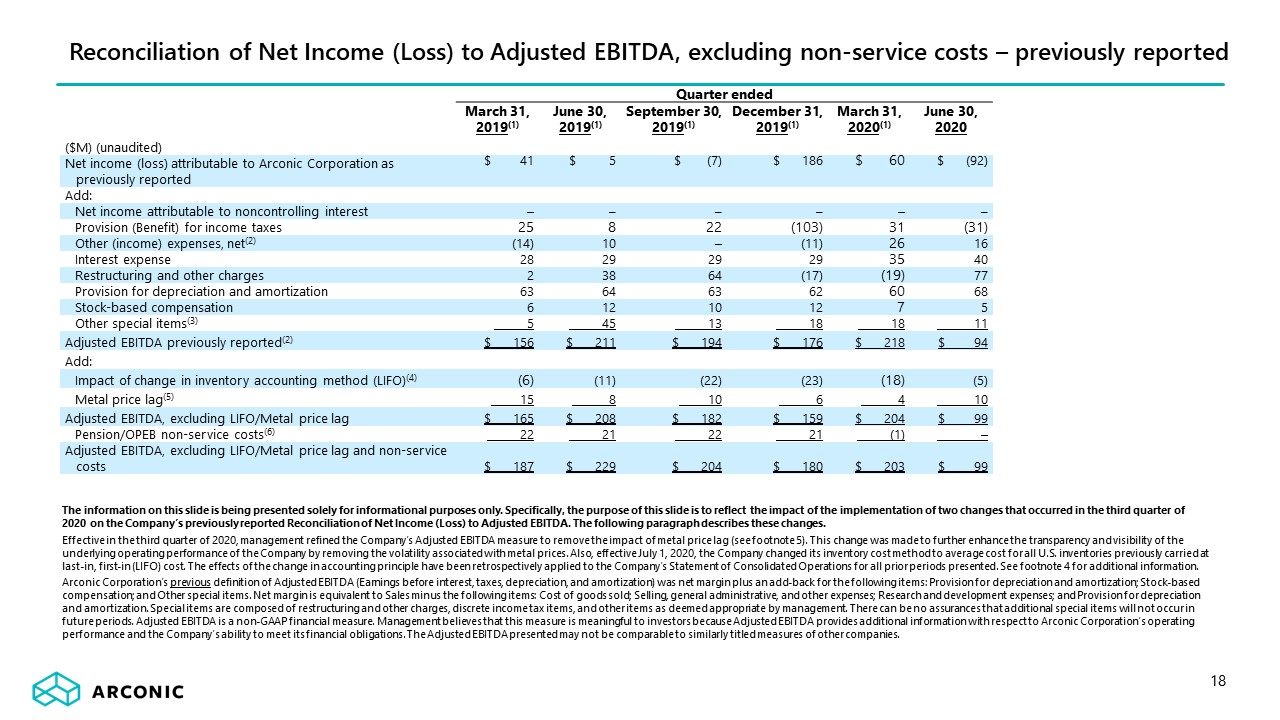
18 Quarter ended March 31, 2019(1) June 30, 2019(1) September 30, 2019(1) December
31, 2019(1) March 31,2020(1) June 30, 2020 ($M) (unaudited) Net income (loss) attributable to Arconic Corporation as previously reported $ 41 $ 5 $ (7) $ 186 $ 60 $ (92) Add: Net income
attributable to noncontrolling interest – – – – – – Provision (Benefit) for income taxes 25 8 22 (103) 31 (31) Other (income) expenses, net(2) (14) 10 – (11) 26 16 Interest expense 28 29 29 29 35 40 Restructuring
and other charges 2 38 64 (17) (19) 77 Provision for depreciation and amortization 63 64 63 62 60 68 Stock-based compensation 6 12 10 12 7 5 Other special items(3) 5 45 13 18 18 11 Adjusted
EBITDA previously reported(2) $ 156 $ 211 $ 194 $ 176 $ 218 $ 94 Add: Impact of change in inventory accounting method (LIFO)(4) (6) (11) (22) (23) (18) (5) Metal price lag(5) 15 8 10 6 4
10 Adjusted EBITDA, excluding LIFO/Metal price lag $ 165 $ 208 $ 182 $ 159 $ 204 $ 99 Pension/OPEB non-service costs(6) 22 21 22 21 (1) – Adjusted EBITDA, excluding LIFO/Metal price lag and non-service costs $ 187 $
229 $ 204 $ 180 $ 203 $ 99 The information on this slide is being presented solely for informational purposes only. Specifically, the purpose of this slide is to reflect the impact of the implementation of two changes that
occurred in the third quarter of 2020 on the Company’s previously reported Reconciliation of Net Income (Loss) to Adjusted EBITDA. The following paragraph describes these changes.Effective in the third quarter of 2020, management refined the
Company’s Adjusted EBITDA measure to remove the impact of metal price lag (see footnote 5). This change was made to further enhance the transparency and visibility of the underlying operating performance of the Company by removing the
volatility associated with metal prices. Also, effective July 1, 2020, the Company changed its inventory cost method to average cost for all U.S. inventories previously carried at last-in, first-in (LIFO) cost. The effects of the change in
accounting principle have been retrospectively applied to the Company’s Statement of Consolidated Operations for all prior periods presented. See footnote 4 for additional information.Arconic Corporation’s previous definition of Adjusted
EBITDA (Earnings before interest, taxes, depreciation, and amortization) was net margin plus an add-back for the following items: Provision for depreciation and amortization; Stock-based compensation; and Other special items. Net margin is
equivalent to Sales minus the following items: Cost of goods sold; Selling, general administrative, and other expenses; Research and development expenses; and Provision for depreciation and amortization. Special items are composed of
restructuring and other charges, discrete income tax items, and other items as deemed appropriate by management. There can be no assurances that additional special items will not occur in future periods. Adjusted EBITDA is a non-GAAP
financial measure. Management believes that this measure is meaningful to investors because Adjusted EBITDA provides additional information with respect to Arconic Corporation’s operating performance and the Company’s ability to meet its
financial obligations. The Adjusted EBITDA presented may not be comparable to similarly titled measures of other companies. Reconciliation of Net Income (Loss) to Adjusted EBITDA, excluding non-service costs – previously reported
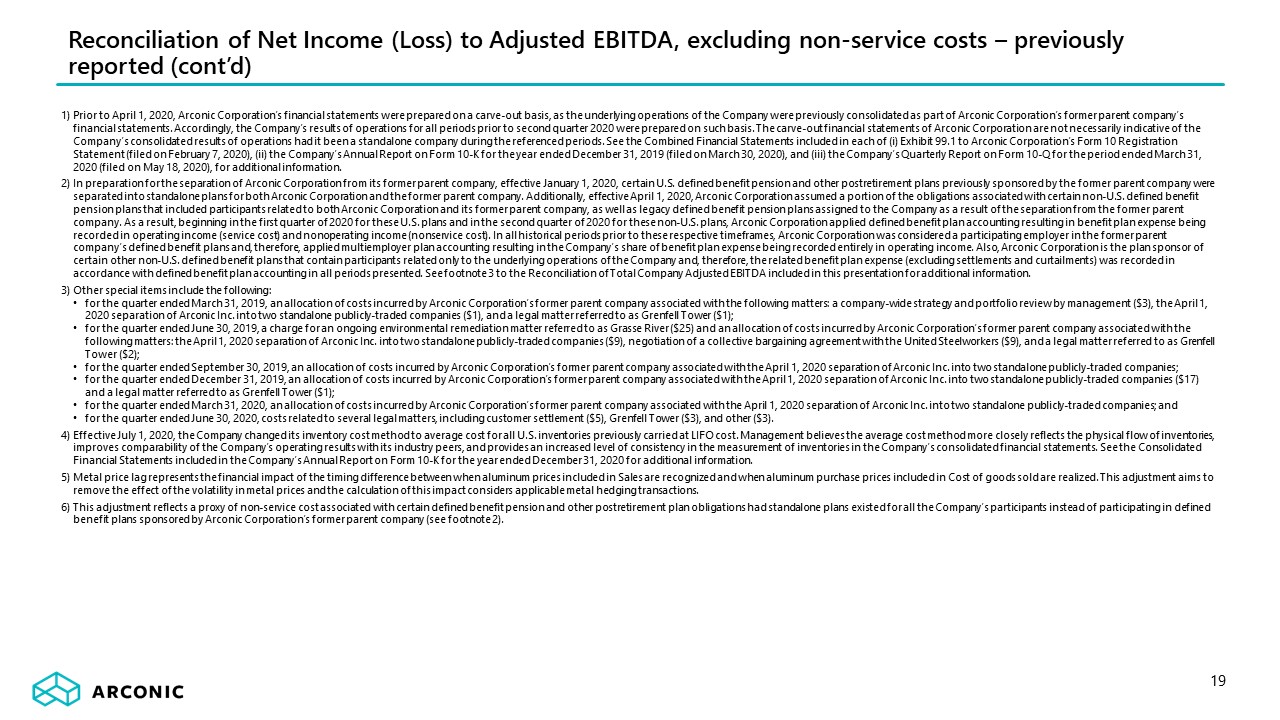
1) Prior to April 1, 2020, Arconic Corporation’s financial statements were prepared on a carve-out
basis, as the underlying operations of the Company were previously consolidated as part of Arconic Corporation’s former parent company’s financial statements. Accordingly, the Company’s results of operations for all periods prior to second
quarter 2020 were prepared on such basis. The carve-out financial statements of Arconic Corporation are not necessarily indicative of the Company’s consolidated results of operations had it been a standalone company during the referenced
periods. See the Combined Financial Statements included in each of (i) Exhibit 99.1 to Arconic Corporation’s Form 10 Registration Statement (filed on February 7, 2020), (ii) the Company’s Annual Report on Form 10-K for the year ended December
31, 2019 (filed on March 30, 2020), and (iii) the Company’s Quarterly Report on Form 10-Q for the period ended March 31, 2020 (filed on May 18, 2020), for additional information.2) In preparation for the separation of Arconic Corporation from
its former parent company, effective January 1, 2020, certain U.S. defined benefit pension and other postretirement plans previously sponsored by the former parent company were separated into standalone plans for both Arconic Corporation and
the former parent company. Additionally, effective April 1, 2020, Arconic Corporation assumed a portion of the obligations associated with certain non-U.S. defined benefit pension plans that included participants related to both Arconic
Corporation and its former parent company, as well as legacy defined benefit pension plans assigned to the Company as a result of the separation from the former parent company. As a result, beginning in the first quarter of 2020 for these
U.S. plans and in the second quarter of 2020 for these non-U.S. plans, Arconic Corporation applied defined benefit plan accounting resulting in benefit plan expense being recorded in operating income (service cost) and nonoperating income
(nonservice cost). In all historical periods prior to these respective timeframes, Arconic Corporation was considered a participating employer in the former parent company’s defined benefit plans and, therefore, applied multiemployer plan
accounting resulting in the Company’s share of benefit plan expense being recorded entirely in operating income. Also, Arconic Corporation is the plan sponsor of certain other non-U.S. defined benefit plans that contain participants related
only to the underlying operations of the Company and, therefore, the related benefit plan expense (excluding settlements and curtailments) was recorded in accordance with defined benefit plan accounting in all periods presented. See footnote
3 to the Reconciliation of Total Company Adjusted EBITDA included in this presentation for additional information.3) Other special items include the following:for the quarter ended March 31, 2019, an allocation of costs incurred by Arconic
Corporation’s former parent company associated with the following matters: a company-wide strategy and portfolio review by management ($3), the April 1, 2020 separation of Arconic Inc. into two standalone publicly-traded companies ($1), and a
legal matter referred to as Grenfell Tower ($1);for the quarter ended June 30, 2019, a charge for an ongoing environmental remediation matter referred to as Grasse River ($25) and an allocation of costs incurred by Arconic Corporation’s
former parent company associated with the following matters: the April 1, 2020 separation of Arconic Inc. into two standalone publicly-traded companies ($9), negotiation of a collective bargaining agreement with the United Steelworkers ($9),
and a legal matter referred to as Grenfell Tower ($2);for the quarter ended September 30, 2019, an allocation of costs incurred by Arconic Corporation’s former parent company associated with the April 1, 2020 separation of Arconic Inc. into
two standalone publicly-traded companies;for the quarter ended December 31, 2019, an allocation of costs incurred by Arconic Corporation’s former parent company associated with the April 1, 2020 separation of Arconic Inc. into two standalone
publicly-traded companies ($17) and a legal matter referred to as Grenfell Tower ($1);for the quarter ended March 31, 2020, an allocation of costs incurred by Arconic Corporation’s former parent company associated with the April 1, 2020
separation of Arconic Inc. into two standalone publicly-traded companies; andfor the quarter ended June 30, 2020, costs related to several legal matters, including customer settlement ($5), Grenfell Tower ($3), and other ($3).4) Effective
July 1, 2020, the Company changed its inventory cost method to average cost for all U.S. inventories previously carried at LIFO cost. Management believes the average cost method more closely reflects the physical flow of inventories, improves
comparability of the Company’s operating results with its industry peers, and provides an increased level of consistency in the measurement of inventories in the Company’s consolidated financial statements. See the Consolidated Financial
Statements included in the Company’s Annual Report on Form 10-K for the year ended December 31, 2020 for additional information.5) Metal price lag represents the financial impact of the timing difference between when aluminum prices included
in Sales are recognized and when aluminum purchase prices included in Cost of goods sold are realized. This adjustment aims to remove the effect of the volatility in metal prices and the calculation of this impact considers applicable metal
hedging transactions.6) This adjustment reflects a proxy of non-service cost associated with certain defined benefit pension and other postretirement plan obligations had standalone plans existed for all the Company’s participants instead of
participating in defined benefit plans sponsored by Arconic Corporation’s former parent company (see footnote 2). 19 Reconciliation of Net Income (Loss) to Adjusted EBITDA, excluding non-service costs – previously reported (cont’d)
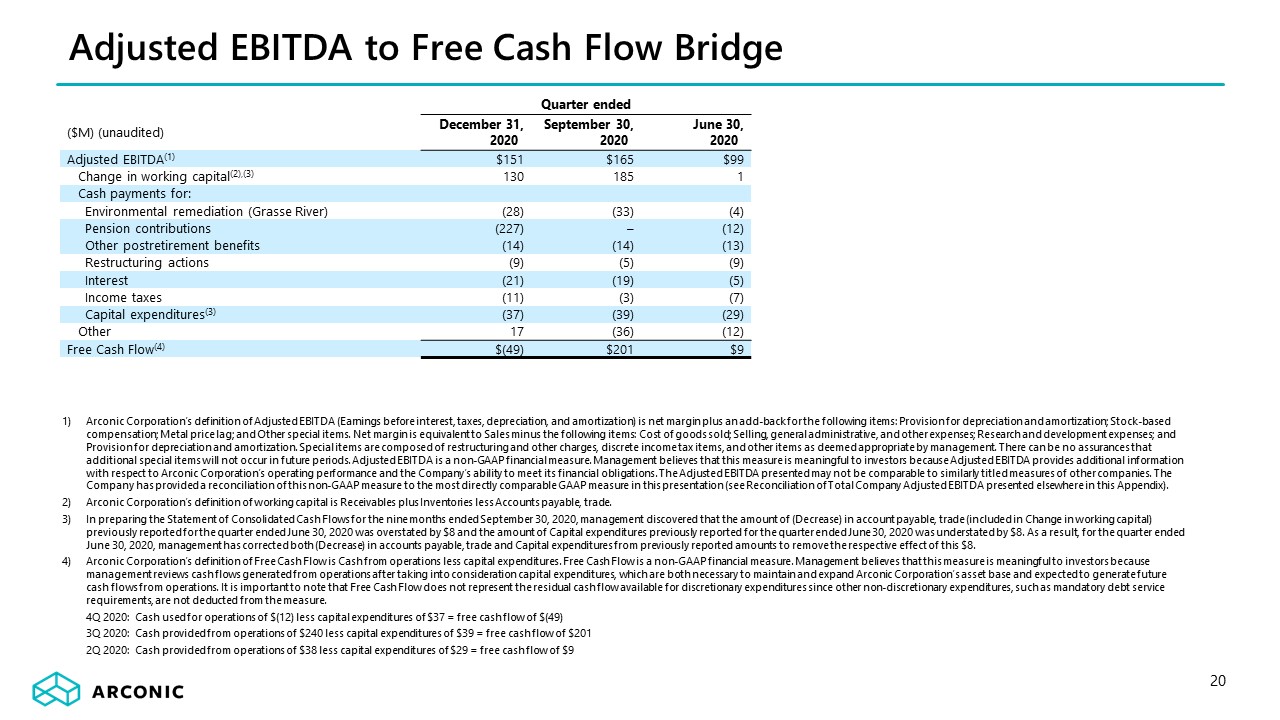
20 Adjusted EBITDA to Free Cash Flow Bridge Quarter ended ($M) (unaudited) December 31,
2020 September 30, 2020 June 30, 2020 Adjusted EBITDA(1) $151 $165 $99 Change in working capital(2),(3) 130 185 1 Cash payments for: Environmental remediation (Grasse River) (28) (33) (4) Pension
contributions (227) – (12) Other postretirement benefits (14) (14) (13) Restructuring actions (9) (5) (9) Interest (21) (19) (5) Income taxes (11) (3) (7) Capital expenditures(3) (37) (39) (29)
Other 17 (36) (12) Free Cash Flow(4) $(49) $201 $9 Arconic Corporation’s definition of Adjusted EBITDA (Earnings before interest, taxes, depreciation, and amortization) is net margin plus an add-back for the following items: Provision
for depreciation and amortization; Stock-based compensation; Metal price lag; and Other special items. Net margin is equivalent to Sales minus the following items: Cost of goods sold; Selling, general administrative, and other expenses;
Research and development expenses; and Provision for depreciation and amortization. Special items are composed of restructuring and other charges, discrete income tax items, and other items as deemed appropriate by management. There can be no
assurances that additional special items will not occur in future periods. Adjusted EBITDA is a non-GAAP financial measure. Management believes that this measure is meaningful to investors because Adjusted EBITDA provides additional
information with respect to Arconic Corporation’s operating performance and the Company’s ability to meet its financial obligations. The Adjusted EBITDA presented may not be comparable to similarly titled measures of other companies. The
Company has provided a reconciliation of this non-GAAP measure to the most directly comparable GAAP measure in this presentation (see Reconciliation of Total Company Adjusted EBITDA presented elsewhere in this Appendix). Arconic Corporation’s
definition of working capital is Receivables plus Inventories less Accounts payable, trade.In preparing the Statement of Consolidated Cash Flows for the nine months ended September 30, 2020, management discovered that the amount of (Decrease)
in account payable, trade (included in Change in working capital) previously reported for the quarter ended June 30, 2020 was overstated by $8 and the amount of Capital expenditures previously reported for the quarter ended June 30, 2020 was
understated by $8. As a result, for the quarter ended June 30, 2020, management has corrected both (Decrease) in accounts payable, trade and Capital expenditures from previously reported amounts to remove the respective effect of this
$8.Arconic Corporation’s definition of Free Cash Flow is Cash from operations less capital expenditures. Free Cash Flow is a non-GAAP financial measure. Management believes that this measure is meaningful to investors because management
reviews cash flows generated from operations after taking into consideration capital expenditures, which are both necessary to maintain and expand Arconic Corporation’s asset base and expected to generate future cash flows from operations. It
is important to note that Free Cash Flow does not represent the residual cash flow available for discretionary expenditures since other non-discretionary expenditures, such as mandatory debt service requirements, are not deducted from the
measure. 4Q 2020: Cash used for operations of $(12) less capital expenditures of $37 = free cash flow of $(49)3Q 2020: Cash provided from operations of $240 less capital expenditures of $39 = free cash flow of $2012Q 2020: Cash provided from
operations of $38 less capital expenditures of $29 = free cash flow of $9
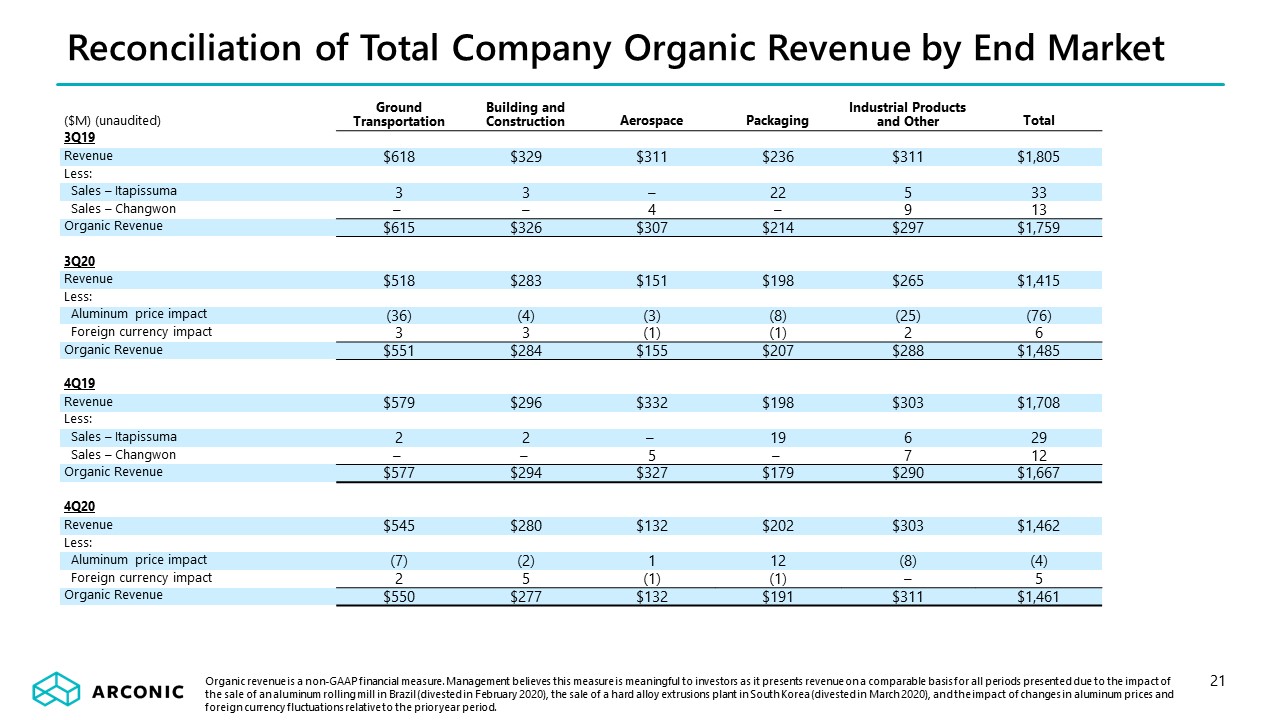
Reconciliation of Total Company Organic Revenue by End Market 21 Organic revenue is a non-GAAP
financial measure. Management believes this measure is meaningful to investors as it presents revenue on a comparable basis for all periods presented due to the impact of the sale of an aluminum rolling mill in Brazil (divested in February
2020), the sale of a hard alloy extrusions plant in South Korea (divested in March 2020), and the impact of changes in aluminum prices and foreign currency fluctuations relative to the prior year period. ($M) (unaudited) Ground
Transportation Building and Construction Aerospace Packaging Industrial Products and Other Total 3Q19 Revenue $618 $329 $311 $236 $311 $1,805 Less: Sales – Itapissuma 3 3 – 22 5 33 Sales –
Changwon – – 4 – 9 13 Organic Revenue $615 $326 $307 $214 $297 $1,759 3Q20 Revenue $518 $283 $151 $198 $265 $1,415 Less: Aluminum price
impact (36) (4) (3) (8) (25) (76) Foreign currency impact 3 3 (1) (1) 2 6 Organic Revenue $551 $284 $155 $207 $288 $1,485 4Q19 Revenue $579 $296 $332 $198 $303 $1,708
Less: Sales – Itapissuma 2 2 – 19 6 29 Sales – Changwon – – 5 – 7 12 Organic Revenue $577 $294 $327 $179 $290 $1,667 4Q20 Revenue $545 $280 $132 $202
$303 $1,462 Less: Aluminum price impact (7) (2) 1 12 (8) (4) Foreign currency impact 2 5 (1) (1) – 5 Organic Revenue $550 $277 $132 $191 $311 $1,461
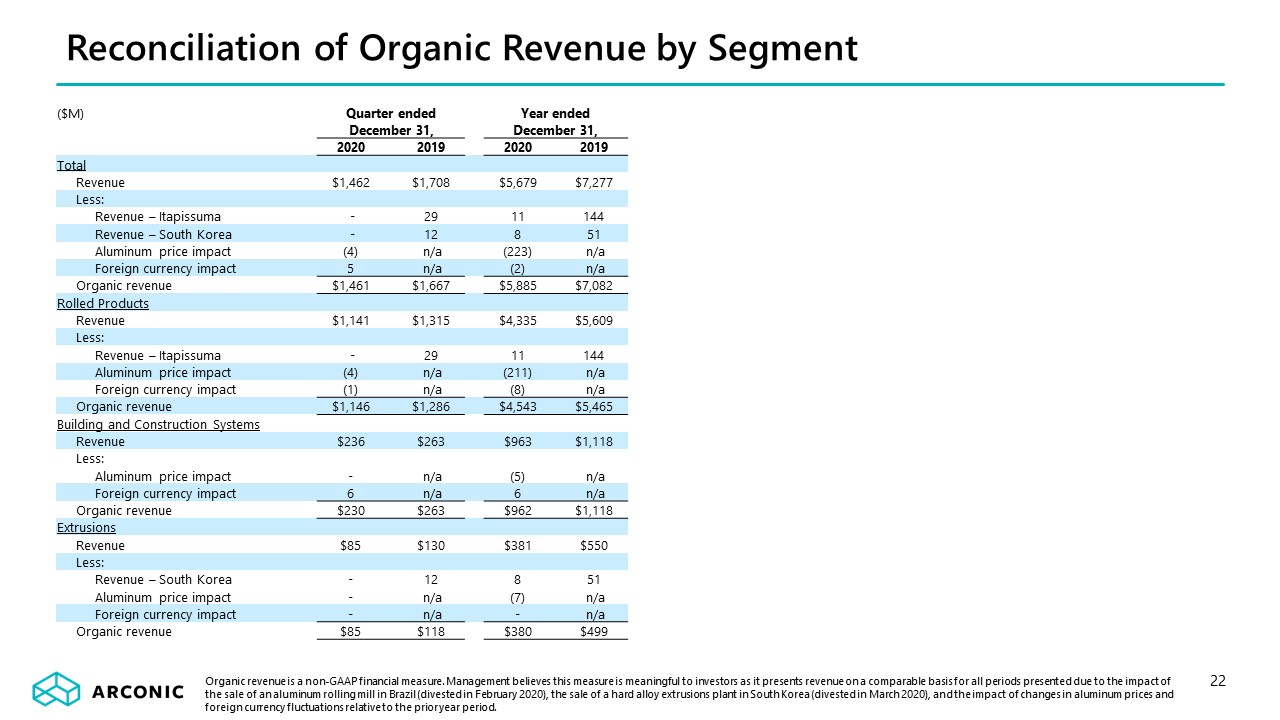
Reconciliation of Organic Revenue by Segment 22 Organic revenue is a non-GAAP financial measure.
Management believes this measure is meaningful to investors as it presents revenue on a comparable basis for all periods presented due to the impact of the sale of an aluminum rolling mill in Brazil (divested in February 2020), the sale of a
hard alloy extrusions plant in South Korea (divested in March 2020), and the impact of changes in aluminum prices and foreign currency fluctuations relative to the prior year period. ($M) Quarter ended Year
ended December 31, December 31, 2020 2019 2020 2019 Total Revenue $1,462 $1,708 $5,679 $7,277 Less: Revenue –
Itapissuma - 29 11 144 Revenue – South Korea - 12 8 51 Aluminum price impact (4) n/a (223) n/a Foreign currency impact 5 n/a (2) n/a Organic
revenue $1,461 $1,667 $5,885 $7,082 Rolled Products Revenue $1,141 $1,315 $4,335 $5,609 Less: Revenue – Itapissuma - 29 11
144 Aluminum price impact (4) n/a (211) n/a Foreign currency impact (1) n/a (8) n/a Organic revenue $1,146 $1,286 $4,543 $5,465 Building and Construction
Systems Revenue $236 $263 $963 $1,118 Less: Aluminum price impact - n/a (5) n/a Foreign currency impact 6 n/a 6 n/a
Organic revenue $230 $263 $962 $1,118 Extrusions Revenue $85 $130 $381 $550 Less: Revenue – South
Korea - 12 8 51 Aluminum price impact - n/a (7) n/a Foreign currency impact - n/a - n/a Organic revenue $85 $118 $380 $499
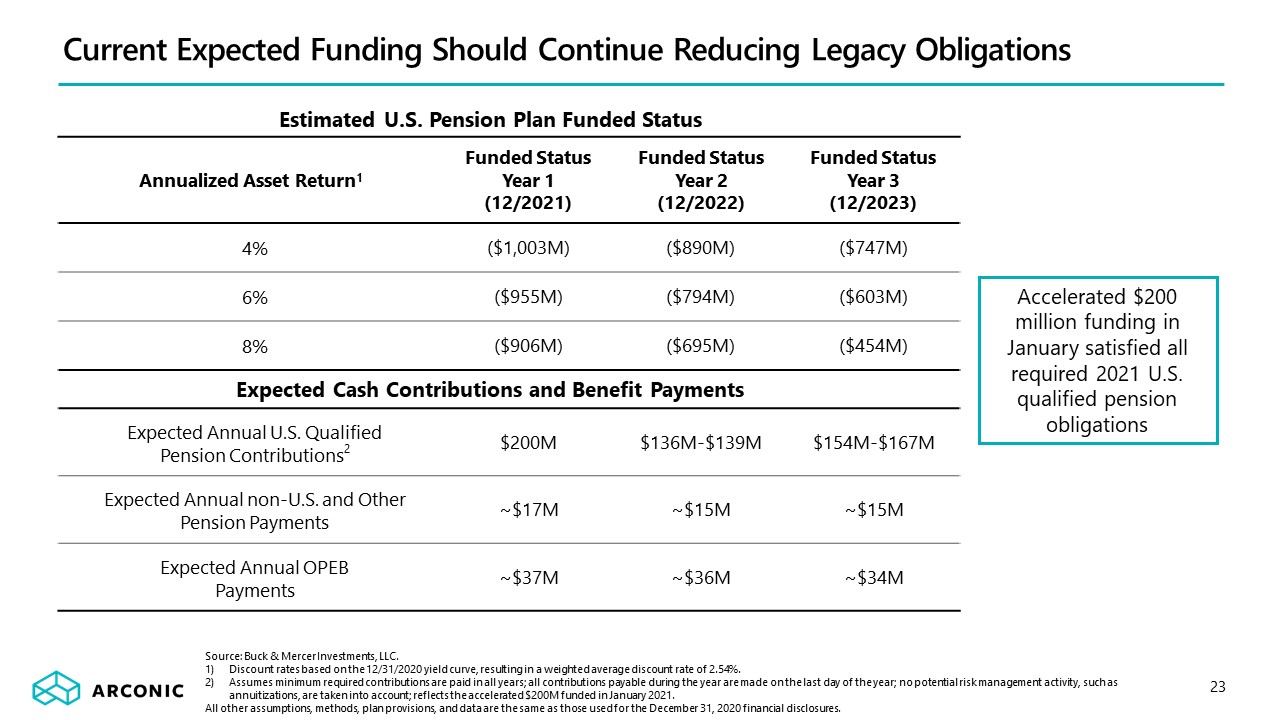
Current Expected Funding Should Continue Reducing Legacy Obligations 23 Annualized Asset
Return1 Funded StatusYear 1(12/2021) Funded StatusYear 2(12/2022) Funded StatusYear 3(12/2023) 4% ($1,003M) ($890M) ($747M) 6% ($955M) ($794M) ($603M) 8% ($906M) ($695M) ($454M) Expected Annual U.S. QualifiedPension
Contributions2 $200M $136M-$139M $154M-$167M Expected Annual non-U.S. and OtherPension Payments ~$17M ~$15M ~$15M Expected Annual OPEBPayments ~$37M ~$36M ~$34M Estimated U.S. Pension Plan Funded Status Source: Buck & Mercer
Investments, LLC.Discount rates based on the 12/31/2020 yield curve, resulting in a weighted average discount rate of 2.54%.Assumes minimum required contributions are paid in all years; all contributions payable during the year are made on
the last day of the year; no potential risk management activity, such as annuitizations, are taken into account; reflects the accelerated $200M funded in January 2021.All other assumptions, methods, plan provisions, and data are the same as
those used for the December 31, 2020 financial disclosures. Accelerated $200 million funding in January satisfied all required 2021 U.S. qualified pension obligations Expected Cash Contributions and Benefit Payments
